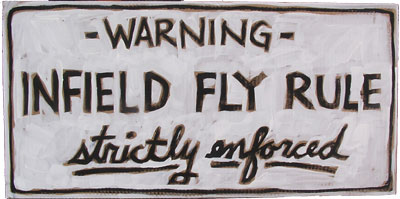If you are like me, you hope you
never hear the phrase, “Infield Fly Rule” again. However, Baseball has asked Humor Me to explain the Infield Fly
Rule so that fans will just sit down, shut up and enjoy the game. Oh yeah, also
buy the 14,000 alternative baseball caps. My commentary is in bold print.
When it seems apparent that a batted ball will be an Infield Fly, the umpire shall immediately (or whenever he feels like it) declare "Infield Fly'' for the benefit of the runners. If the ball is near the baselines, the umpire shall declare "Infield Fly, if Fair.'' (It would help if the umpire would flap his arms up and down while saying “Infield Fly if Fair”.)
The ball is alive and runners may advance at the risk of the ball being caught, or retouch and advance after the ball is touched, the same as on any fly ball. If the hit becomes a foul ball, it is treated the same as any foul. (The fans of the home team must then stand and do “The Chicken Dance”)
If a declared Infield Fly is allowed to fall untouched to the ground, and bounces foul before passing first or third base, it is a foul ball. If a declared Infield Fly falls untouched to the ground outside the baseline, and bounces fair before passing first or third base, it is an Infield Fly. (And we get to stand around in amazement as to how bright we are that we understand this rule.)
Rule 2.00 (Infield Fly) Comment: On the infield fly rule the umpire is to rule whether the ball could ordinarily have been handled by an infielder - not by some arbitrary limitation such as the grass, or the base lines (or time, space or common sense). The umpire must rule also that a ball is an infield fly, even if handled by an outfielder, if, in the umpire's judgment, the ball could have been as easily handled by an infielder. (So, shut up Atlanta. You shouldn’t have made three errors in the game.) The infield fly is in no sense to be considered an appeal play. (Shut up Atlanta. A murder conviction can be appealed. A judgment call can’t because..it just can’t so shut up.) The umpire's judgment must govern, and the decision should be made immediately (or his definition of “immediately” which could involve weeks or months.)
When an infield fly rule is called, runners may advance at their own risk. If on an infield fly rule, the infielder intentionally drops a fair ball, the ball remains in play despite the provisions of Rule 6.05(l). The infield fly rule takes precedence. Fans are then allowed to throw plastic bottles of waters and/or beer onto the field in accordance with Baseball’s “HEY MAN THIS IS BULL FECES” clause in the fan agreement. When fans agree to follow baseball, they agree that it is a game that has a lot of quirks, including, but not limited to, standing up and singing near the end of the game.
Additionally, if this play should happen to occur in a playoff game in New York, Boston, or Philadelphia, baseball will pretend that this rule does not exists. For the good of the game.
For a better review of this rule, here's Joe Posnanski http://joeposnanski.blogspot.com/2012/10/wild.html




No comments:
Post a Comment